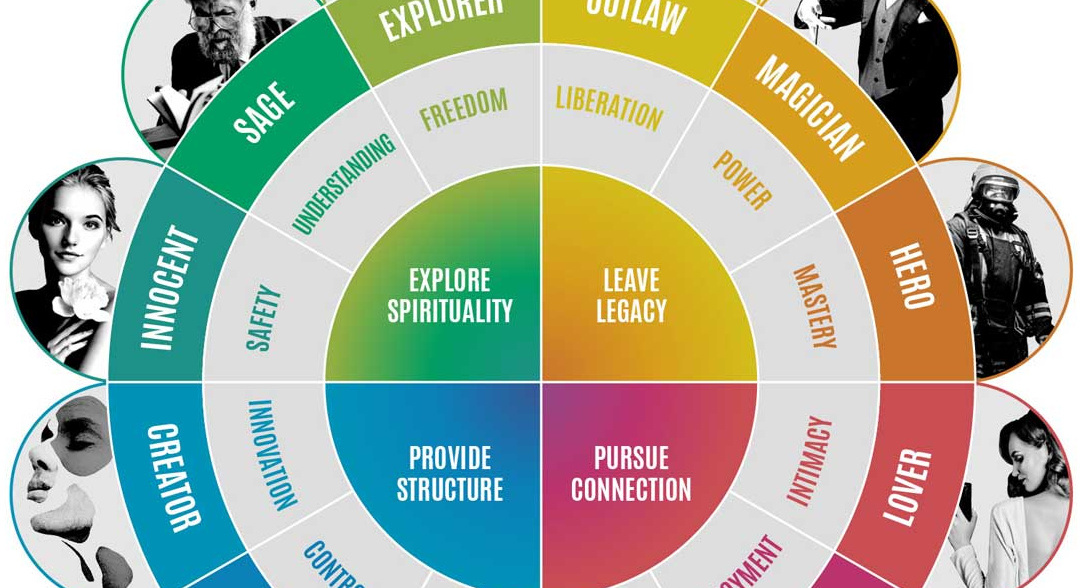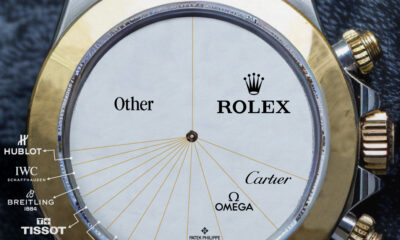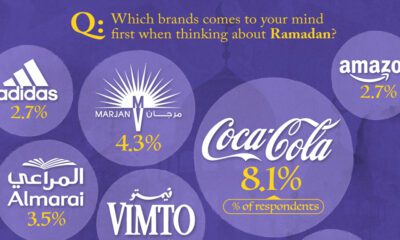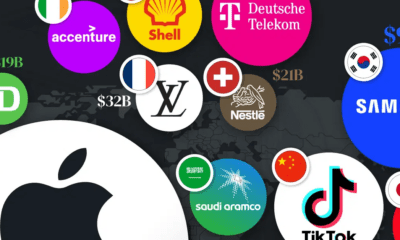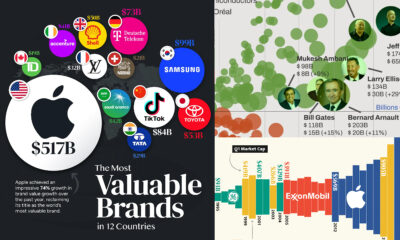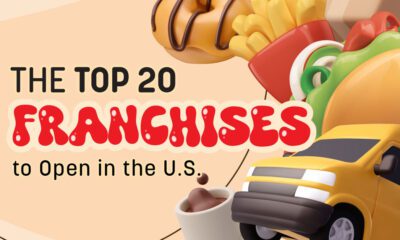Misc
12 Brand Archetypes That Marketers Use to Get Your Attention
Every day, we get bombarded with over 5,000 ads or brand messages vying to capture our attention.
Most of them get deflected by our unconscious minds and hold little relevance or appeal to our daily lives. But at the same time, a select few of these messages get through to us, and we may even feel a sense of personal identity with them.
Sure, these brands might sell products that we like – but it’s also the storytelling behind the brand’s messaging that can resonate with our individual lives.
Brand Archetypes
How do brands craft symbolism and messaging that have consistent appeal?
There are many strategies and techniques used by marketers to accomplish this, but one interesting way to view it is through the lens of archetypes. Brands can anchor their communications to enduring personas or profiles that feed into the human experience, and this allows consumers to identify narratives and symbolism quickly and effectively.
Archetypes are the heartbeat of a brand because they convey a meaning that makes customers relate to a product as if it actually were alive in some way, they have a relationship with it and care about it.
– The Hero and the Outlaw: Building Extraordinary Brands Through the Power of Archetypes
The following 12 archetypes were defined by Swiss psychiatrist Carl Jung and are commonly cited in the fields of marketing, psychology, anthropology, and other social sciences. The graphic comes from a guide put together by Iconic Fox:
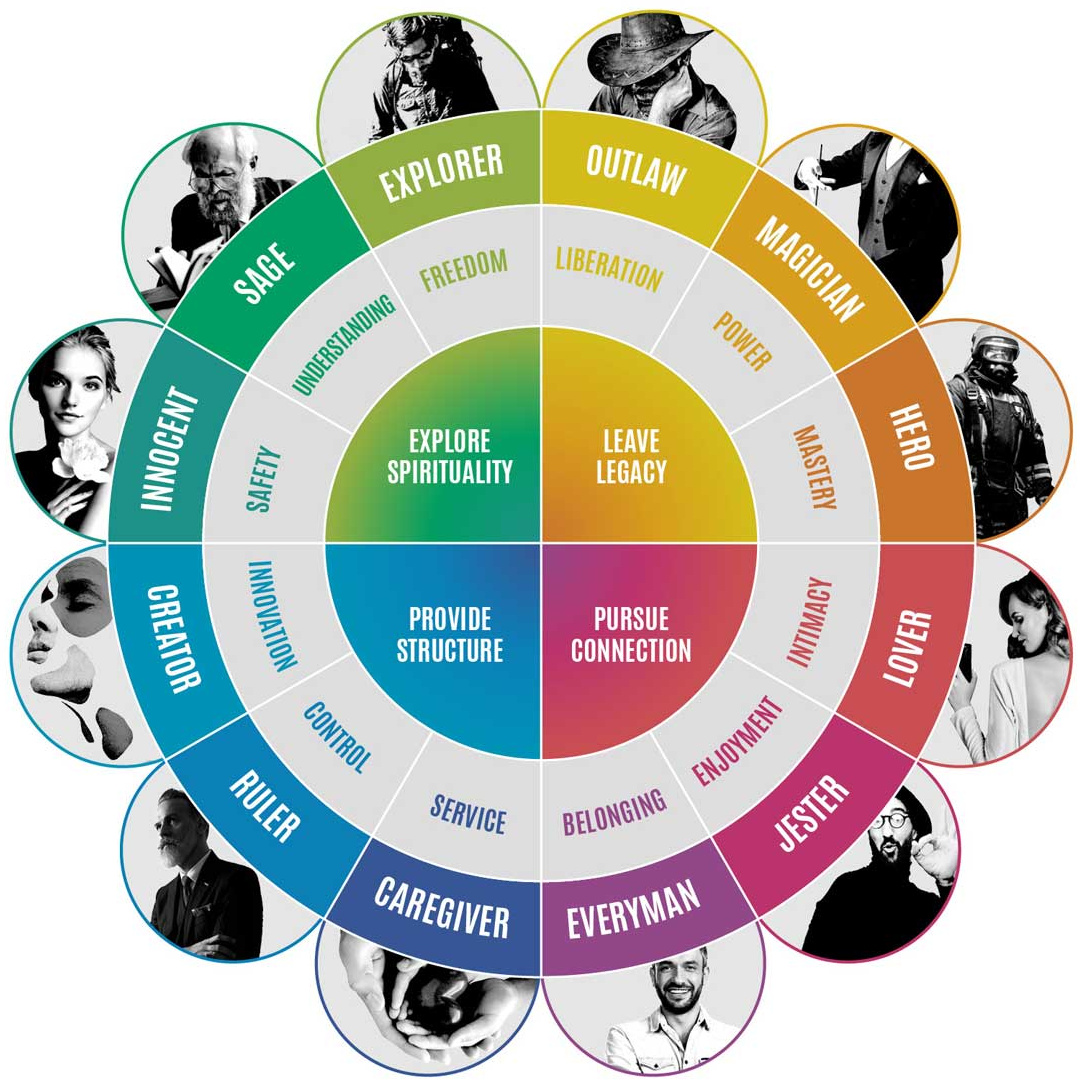
Each brand archetype slots in with the common narratives we see and experience regularly in our culture.
Which do you think Harley Davidson matches the best? What about a brand like Apple?
Brand Archetype Examples
Here are two example archetypes – also from Iconic Fox – that will help better demonstrate the concept. It’s worth looking closely at the brand voice, strategies, and values exemplified by each archetype, and thinking about how they connect to human storytelling and the types of characters we are familiar with throughout history.
We’ll start with “The Outlaw”…
![]()
![]()
About “The Outlaw”
James Dean. William Wallace. Hermoine Granger. Jack Sparrow.
These are all people or characters that see rules as things that are meant to be broken, especially in the name of liberation. The Outlaw appeals to people and stories driven by independence, righteousness, change, and even revenge – and when used as a brand archetype, The Outlaw conveys a message that one can do better than the status quo.
Harley Davidson is a fantastic example of a brand that fits with this archetype.
Next up is “The Creator”…
![]()
![]()
About “The Creator”
Tony Stark. Carrie Bradshaw. John Hammond. Nüwa.
These are all people or characters that see the value of creation of new things. The Creator appeals to those that value self-expression, vision, imagination, and inspiration.
Apple is the iconic brand associated with this archetype, but Lego, Adobe, and Etsy could be considered good fits as well.
More Brand Archetypes
In a world with no shortage of media stimuli, brand archetypes enable marketers to pin down specific imagery and ideas that they know can make a direct impact with their audience. Archetypes are enduring, tried-and-true representations of the stories we have told ourselves for centuries, and that some would even say are entrenched in human nature.
For more on archetypes in marketing, including expanded definitions on the other 10 that we did not cover in depth here, we recommend reading the graphical guide put together by Iconic Fox.
Misc
How Hard Is It to Get Into an Ivy League School?
We detail the admission rates and average annual cost for Ivy League schools, as well as the median SAT scores required to be accepted.

How Hard Is It to Get Into an Ivy League School?
This was originally posted on our Voronoi app. Download the app for free on iOS or Android and discover incredible data-driven charts from a variety of trusted sources.
Ivy League institutions are renowned worldwide for their academic excellence and long-standing traditions. But how hard is it to get into one of the top universities in the U.S.?
In this graphic, we detail the admission rates and average annual cost for Ivy League schools, as well as the median SAT scores required to be accepted. The data comes from the National Center for Education Statistics and was compiled by 24/7 Wall St.
Note that “average annual cost” represents the net price a student pays after subtracting the average value of grants and/or scholarships received.
Harvard is the Most Selective
The SAT is a standardized test commonly used for college admissions in the United States. It’s taken by high school juniors and seniors to assess their readiness for college-level academic work.
When comparing SAT scores, Harvard and Dartmouth are among the most challenging universities to gain admission to. The median SAT scores for their students are 760 for reading and writing and 790 for math. Still, Harvard has half the admission rate (3.2%) compared to Dartmouth (6.4%).
| School | Admission rate (%) | SAT Score: Reading & Writing | SAT Score: Math | Avg Annual Cost* |
|---|---|---|---|---|
| Harvard University | 3.2 | 760 | 790 | $13,259 |
| Columbia University | 3.9 | 750 | 780 | $12,836 |
| Yale University | 4.6 | 760 | 780 | $16,341 |
| Brown University | 5.1 | 760 | 780 | $26,308 |
| Princeton University | 5.7 | 760 | 780 | $11,080 |
| Dartmouth College | 6.4 | 760 | 790 | $33,023 |
| University of Pennsylvania | 6.5 | 750 | 790 | $14,851 |
| Cornell University | 7.5 | 750 | 780 | $29,011 |
*Costs after receiving federal financial aid.
Additionally, Dartmouth has the highest average annual cost at $33,000. Princeton has the lowest at $11,100.
While student debt has surged in the United States in recent years, hitting $1.73 trillion in 2023, the worth of obtaining a degree from any of the schools listed surpasses mere academics. This is evidenced by the substantial incomes earned by former students.
Harvard grads, for example, have the highest average starting salary in the country, at $91,700.
-

 Maps2 weeks ago
Maps2 weeks agoMapped: Average Wages Across Europe
-

 Money1 week ago
Money1 week agoWhich States Have the Highest Minimum Wage in America?
-

 Real Estate1 week ago
Real Estate1 week agoRanked: The Most Valuable Housing Markets in America
-

 Markets1 week ago
Markets1 week agoCharted: Big Four Market Share by S&P 500 Audits
-

 AI1 week ago
AI1 week agoThe Stock Performance of U.S. Chipmakers So Far in 2024
-

 Automotive2 weeks ago
Automotive2 weeks agoAlmost Every EV Stock is Down After Q1 2024
-

 Money2 weeks ago
Money2 weeks agoWhere Does One U.S. Tax Dollar Go?
-

 Green2 weeks ago
Green2 weeks agoRanked: Top Countries by Total Forest Loss Since 2001

